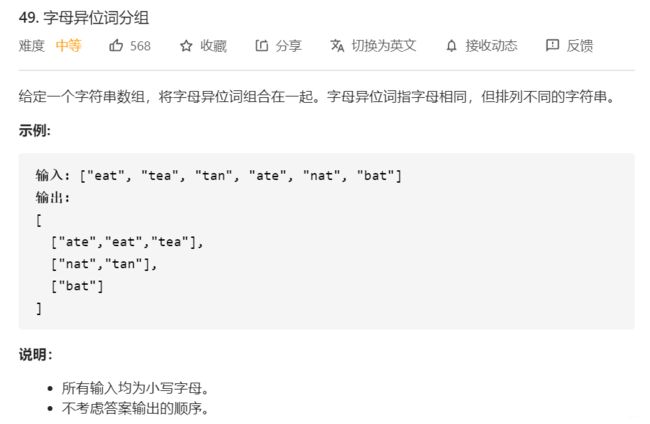- 【LeetCode 热题 100】234. 回文链表——快慢指针+反转链表
xumistore
LeetCodeleetcode链表算法java
Problem:234.回文链表题目:给你一个单链表的头节点head,请你判断该链表是否为回文链表。如果是,返回true;否则,返回false。文章目录整体思路完整代码时空复杂度时间复杂度:O(N)空间复杂度:O(1)整体思路这段代码旨在解决一个经典的链表问题:回文链表(PalindromeLinkedList)。问题要求判断一个单链表是否是回文结构,即从前向后读和从后向前读的序列是否相同。例如1
- 【LeetCode 热题 100】48. 旋转图像——转置+水平翻转
xumistore
LeetCodeleetcode算法职场和发展java
Problem:48.旋转图像题目:给定一个n×n的二维矩阵matrix表示一个图像。请你将图像顺时针旋转90度。你必须在原地旋转图像,这意味着你需要直接修改输入的二维矩阵。请不要使用另一个矩阵来旋转图像。文章目录整体思路完整代码时空复杂度时间复杂度:O(N^2)空间复杂度:O(1)整体思路这段代码旨在解决一个经典的矩阵问题:旋转图像(RotateImage)。问题要求将一个NxN的二维矩阵顺时针
- 【一起来学AI大模型】算法核心:数组/哈希表/树/排序/动态规划(LeetCode精练)
运器123
AI大模型python开发语言人工智能AIAI编程算法散列表
以下是五大核心算法的重点解析和LeetCode经典题解,包含最优解法和模板代码:一、数组操作(双指针/滑动窗口)核心思想:通过索引指针高效遍历与操作数组1.移动零(No.283)defmoveZeroes(nums):slow=0forfastinrange(len(nums)):ifnums[fast]!=0:nums[slow],nums[fast]=nums[fast],nums[slow]
- 暑假算法日记第三天
目标:刷完灵神专题训练算法题单阶段目标:【算法题单】滑动窗口与双指针LeetCode题目:3439.重新安排会议得到最多空余时间I2134.最少交换次数来组合所有的1II1297.子串的最大出现次数2653.滑动子数组的美丽值1888.使二进制字符串字符交替的最少反转次数567.字符串的排列438.找到字符串中所有字母异位词30.串联所有单词的子串2156.查找给定哈希值的子串其他:今日总结往期打
- Leetcode刷题java之520(检测大写字母)
qq_42342642
leetcodejava算法
执行结果:通过显示详情添加备注执行用时:1ms,在所有Java提交中击败了98.19%的用户内存消耗:36.8MB,在所有Java提交中击败了57.52%的用户通过测试用例:550/550
- LeetCode1004. 最大连续1的个数 III
Zedthm
算法javaleetcode
题目分析本题要求在最多翻转K个0的条件下,找到二进制数组中最长的连续1子数组。翻转操作实际上是将0视为可用资源,用来扩展连续1的区间。解题思路滑动窗口(双指针):核心思想:维护一个窗口,确保窗口内最多包含K个0(即最多可翻转K次)右指针:遍历数组,扩展窗口左指针:当窗口内0的数量超过K时,收缩窗口直到满足条件关键操作:遇到0时增加计数器当0的数量超过K时,移动左指针直到移除一个0始终记录窗口的最大
- 【力扣(LeetCode)】数据挖掘面试题0013:1264. 页面推荐(泛化后,基于MySQL题解)
言析数智
数据挖掘常见面试题leetcode数据挖掘mysql笔试笔试题
文章大纲一、题目要求:二、模拟数据构建三、题解参考方案朋友关系列表:Friendship+---------------+---------+|ColumnName|Type|+---------------+---------+|user1_id|int||user2_id|int|+---------------+---------+(user1_id,user2_id)是这张表具有唯一值的列
- 《力扣》链表 | 19. 删除链表的倒数第 N 个结点 C++题解
一只一只
算法数据结构链表c++leetcode
19.删除链表的倒数第N个结点-力扣(LeetCode)给你一个链表,删除链表的倒数第n个结点,并且返回链表的头结点。示例1:输入:head=[1,2,3,4,5],n=2输出:[1,2,3,5]好神奇的解法,有股相对运动的赶脚双指针:a,b(同时指向头节点)1.先让a指针移动n个节点2.然后a,b一起移动,当a移动到末尾的时候,b就恰好移动到倒数第n个数也就是我们通过a指针限制b只能移动(len
- 代码随想录算法训练营第十一天
天天开心(∩_∩)
算法
LeetCode.150逆波兰表达式求值题目链接逆波兰表达式求值题解classSolution{publicintevalRPN(String[]tokens){Stackcstack=newStackset=newHashSetdeque=newLinkedListdeque.getLast()){deque.removeLast();}deque.add(val);}intpeek(){ret
- LeetCode-最长回文子串
踏实写代码,认真搞学术的小研
leetcode
classSolution:deflongestPalindrome(self,s:str)->str:n=len(s)#创建一个二维数组dp,用于记录回文子串的信息dp=[[False]*nfor_inrange(n)]start=0#记录最长回文子串的起始位置max_len=1#记录最长回文子串的长度#初始化单个字符和相邻两个字符是回文子串的情况foriinrange(n):dp[i][i]=
- (LeetCode)Java 求解最长回文子串
南淮北安
冲刺大厂之Java刷题笔记leetcode字符串动态规划java算法
文章目录一、题解二、常规理解三、简单理解四、总结一、题解给定一个字符串s,找到s中最长的回文子串。你可以假设s的最大长度为1000。示例1:输入:“babad”输出:“bab”注意:“aba”也是一个有效答案。示例2:输入:“cbbd”输出:“bb”二、常规理解思路就是创建一个二维数组,boolean[][]flag,flag[i][j]表示字符串第i到j是否是回文。边界:字符串长度为1是为TRU
- 最长回文子串-leetCode-005
针对这个问题,共有四种解法,分别是暴力法,中心拓展法,动态规划,Manacher算法解法一:暴力法思路:枚举所有可能的子串,然后判断每个子串是否是回文串,最后找出最长的回文子串。classSolution{publicStringlongestPalindrome(Strings){intn=s.length();if(n==0){return"";}StringmaxPalindrome=s.s
- LeetCode-最长回文子串(005)
一.题目描述给你一个字符串s,找到s中最长的回文子串。二.示例示例1:输入:s="babad"输出:"bab"解释:"aba"同样是符合题意的答案。示例2:输入:s="cbbd"输出:"bb"三.提示:1=0;--i){//从当前字符的下一个字符开始,向后遍历for(intj=i+1;j>1);}}//返回最长回文子串returns.substring(start,start+mx);}//辅助函
- LeetCode-5.最长回文子串 C++实现
一.问题描述给你一个字符串s,找到s中最长的回文子串(如果字符串向前和向后读都相同,则它满足回文性。)。示例1:输入:s="babad"输出:"bab"解释:"aba"同样是符合题意的答案。示例2:输入:s="cbbd"输出:"bb"提示:1usingnamespacestd;classSolution{public:stringlongestPalindrome(strings){intn=s.
- [贪心]BM95 分糖果问题
lanbing
多语言LeeCode的题解算法数据结构leetcode
一、题目牛客题目链接:分糖果问题_牛客题霸_牛客网LeeCode题目链接:135.分发糖果-力扣(LeetCode)题目描述:一群孩子做游戏,现在请你根据游戏得分来发糖果,要求如下:1.每个孩子不管得分多少,起码分到一个糖果。2.任意两个相邻的孩子之间,得分较多的孩子必须拿多一些糖果。(若相同则无此限制)给定一个数组arr代表得分数组,请返回最少需要多少糖果。要求:时间复杂度为O(n)空间复杂度为
- LeetCode-196. 删除重复的电子邮箱
做一个AC梦
LeetCode-数据库leetcode数据库sqlmysql
题目描述表:Person+-------------+---------+|ColumnName|Type|+-------------+---------+|id|int||email|varchar|+-------------+---------+id是该表的主键列(具有唯一值的列)。该表的每一行包含一封电子邮件。电子邮件将不包含大写字母。编写解决方案删除所有重复的电子邮件,只保留一个具有最
- 3333. 找到初始输入字符串 II
咔咔咔的
leetcodec++
3333.找到初始输入字符串II题目链接:3333.找到初始输入字符串II代码如下://参考链接:https://leetcode.cn/problems/find-the-original-typed-string-ii/solutions/3706277/zhao-dao-chu-shi-shu-ru-zi-fu-chuan-ii-b-ldyvclassSolution{public:intp
- DAY08 算法训练营| 字符串part01
天空的孩子
算法
344.反转字符串-力扣(LeetCode)字符串和数组算法题目思路类似反转字符串是经典双指针法(回忆反转链表,有序数组的平方,三数之和,四数之和)classSolution{public:voidreverseString(vector&s){len=s.length();for(inti=0,j=s.size()-1;iusingnamespacestd;intmain(){strings;/
- LeetCode 643.子数组最大平均数 I
题目:给你一个由n个元素组成的整数数组nums和一个整数k。请你找出平均数最大且长度为k的连续子数组,并输出该最大平均数。任何误差小于10-5的答案都将被视为正确答案。思路:定长滑动窗口入更新出代码:classSolution{publicdoublefindMaxAverage(int[]nums,intk){intn=nums.length;doubleans=Integer.MIN_VALU
- leetcode 643. 子数组最大平均数 I
�粉红豹护体
leetcode
子数组最大平均数I给定n个整数,找出平均数最大且长度为k的连续子数组,并输出该最大平均数。示例1:输入:[1,12,-5,-6,50,3],k=4输出:12.75解释:最大平均数(12-5-6+50)/4=51/4=12.75注意:1result){result=cursum;}}return(double)result/k;}}
- LeetCode1456. 定长子串中元音的最大数目
题目分析本题要求在给定字符串中找到长度为k的子串,使其包含的元音字母(a,e,i,o,u)数量最多。这是一个典型的固定窗口大小的滑动窗口问题。解题思路初始化元音数量:先计算字符串前k个字符中的元音数量作为初始值滑动窗口处理:从第k个字符开始向右移动窗口:加入当前字符:如果是元音,计数加1移除窗口左侧字符:如果是元音,计数减1每次移动后更新最大元音数量元音判断优化:使用逻辑或判断字符是否为元音(简单
- leetcode 1394. 找出数组中的幸运数 简单
圣保罗的大教堂
leetcode哈希leetcode
在整数数组中,如果一个整数的出现频次和它的数值大小相等,我们就称这个整数为「幸运数」。给你一个整数数组arr,请你从中找出并返回一个幸运数。如果数组中存在多个幸运数,只需返回最大的那个。如果数组中不含幸运数,则返回-1。示例1:输入:arr=[2,2,3,4]输出:2解释:数组中唯一的幸运数是2,因为数值2的出现频次也是2。示例2:输入:arr=[1,2,2,3,3,3]输出:3解释:1、2以及3
- leetcode 3304. 找出第 K 个字符 I 简单
圣保罗的大教堂
leetcode字符串leetcode
Alice和Bob正在玩一个游戏。最初,Alice有一个字符串word="a"。给定一个正整数k。现在Bob会要求Alice执行以下操作无限次:将word中的每个字符更改为英文字母表中的下一个字符来生成一个新字符串,并将其追加到原始的word。例如,对"c"进行操作生成"cd",对"zb"进行操作生成"zbac"。在执行足够多的操作后,word中至少存在k个字符,此时返回word中第k个字符的值。
- LeetCode643. 子数组最大平均数 I
题目分析本题要求找出一个长度为k的连续子数组,使其平均值最大。由于平均值由子数组和决定,问题转化为寻找最大子数组和(再除以k)。解题思路滑动窗口技巧:先计算第一个窗口(0到k-1)的元素和。将窗口向右滑动(每次移动一位):减去窗口左侧离开的元素加上窗口右侧新增的元素在滑动过程中记录窗口和的最大值。数学优化:平均值=窗口和/k最大化平均值⇨最大化窗口和最终结果=最大窗口和÷k(注意转换为double
- 暑假算法日记第一天
目标:刷完灵神专题训练算法题单阶段目标:【算法题单】滑动窗口与双指针LeetCode题目:1456.定长子串中元音的最大数目643.子数组最大平均数I1343.大小为K且平均值大于等于阈值的子数组数目2090.半径为k的子数组平均值2379.得到K个黑块的最少涂色次数2841.几乎唯一子数组的最大和其他:今日总结1456.定长子串中元音的最大数目跳转:1456.定长子串中元音的最大数目学习:灵神:
- 准备数仓实习面试中回顾SQL题
zhuiQiuMX
sql
550-game-play-analysis-ivhttps://leetcode.com/problems/game-play-analysis-iv/description/连续两天登录的比率,2025年6月10日星期二,date_sub#编写解决方案,报告在首次登录的第二天再次登录的玩家的比率,四舍五入到小数点后两位。换句话说,你需要计算从首次登录日期开始至少连续两天登录的玩家的数量,然后除
- 算法第16天|继续二叉树:二叉搜索树的最小绝对差、二叉搜索树中的众数、二叉树的最近公共祖先
孟大本事要学习
算法学习算法数据结构
今日总结:1、遇到二叉搜索树就要想到中序遍历是一个有序数组。2、递归的时候如果递归有返回值,一定要思考截止条件返回什么3、最近公共祖先问题:如果当前节点是要寻找的某个节点,可以直接返回:如果二叉树右边没有另一个节点,本身就是最近公共祖先;如果有另一个节点,再往下递归也找不到另一个节点。二叉搜索树的最小绝对差:题目链接:530.二叉搜索树的最小绝对差-力扣(LeetCode)整体思路:1、看到二叉搜
- LeetCode 206. 反转链表
Tanecious.
刷题笔记leetcode链表算法
反转列表206.反转链表解法一解法二206.反转链表题目链接:206.反转链表-力扣(LeetCode)题目描述:给你单链表的头节点head,请你反转链表,并返回反转后的链表。解法一/***Definitionforsingly-linkedlist.*structListNode{*intval;*structListNode*next;*};*/typedefstructListNodeLis
- 代码随想录算法训练营第四十四天|动态规划part11
1143.最长公共子序列题目链接:1143.最长公共子序列-力扣(LeetCode)文章讲解:代码随想录思路:其实就是求两个字符串的最长公共子序列的长度与公共子数组的区别是可以不连续,顺序对就可以状态转移方程不一样定义dp[i][j]表示text1的0到i-1与text2的0到j-1的最长公共子序列的长度text1[i-1]==text2[j-1]dp[i][j]=dp[i-1][j-1]+1否则
- 代码随想录算法训练营第四十五天|动态规划part12
xindafu
算法动态规划
115.不同的子序列题目链接:115.不同的子序列-力扣(LeetCode)文章讲解:代码随想录定义dp[i][j]表示s0-i-1与t0-j-1不同的子序列的个数以s=batgtgt=bag为例子s【4】!=t【3】所以dp[5][4]=dp[4][4]也就是不考虑s[4]继续往后s[5]==t[3]也就是s[5]跟t【3】配对上了batgt与bag配对的个数加上batgt与ba配对的个数dp[
- 项目中 枚举与注解的结合使用
飞翔的马甲
javaenumannotation
前言:版本兼容,一直是迭代开发头疼的事,最近新版本加上了支持新题型,如果新创建一份问卷包含了新题型,那旧版本客户端就不支持,如果新创建的问卷不包含新题型,那么新旧客户端都支持。这里面我们通过给问卷类型枚举增加自定义注解的方式完成。顺便巩固下枚举与注解。
一、枚举
1.在创建枚举类的时候,该类已继承java.lang.Enum类,所以自定义枚举类无法继承别的类,但可以实现接口。
- 【Scala十七】Scala核心十一:下划线_的用法
bit1129
scala
下划线_在Scala中广泛应用,_的基本含义是作为占位符使用。_在使用时是出问题非常多的地方,本文将不断完善_的使用场景以及所表达的含义
1. 在高阶函数中使用
scala> val list = List(-3,8,7,9)
list: List[Int] = List(-3, 8, 7, 9)
scala> list.filter(_ > 7)
r
- web缓存基础:术语、http报头和缓存策略
dalan_123
Web
对于很多人来说,去访问某一个站点,若是该站点能够提供智能化的内容缓存来提高用户体验,那么最终该站点的访问者将络绎不绝。缓存或者对之前的请求临时存储,是http协议实现中最核心的内容分发策略之一。分发路径中的组件均可以缓存内容来加速后续的请求,这是受控于对该内容所声明的缓存策略。接下来将讨web内容缓存策略的基本概念,具体包括如如何选择缓存策略以保证互联网范围内的缓存能够正确处理的您的内容,并谈论下
- crontab 问题
周凡杨
linuxcrontabunix
一: 0481-079 Reached a symbol that is not expected.
背景:
*/5 * * * * /usr/IBMIHS/rsync.sh
- 让tomcat支持2级域名共享session
g21121
session
tomcat默认情况下是不支持2级域名共享session的,所有有些情况下登陆后从主域名跳转到子域名会发生链接session不相同的情况,但是只需修改几处配置就可以了。
打开tomcat下conf下context.xml文件
找到Context标签,修改为如下内容
如果你的域名是www.test.com
<Context sessionCookiePath="/path&q
- web报表工具FineReport常用函数的用法总结(数学和三角函数)
老A不折腾
Webfinereport总结
ABS
ABS(number):返回指定数字的绝对值。绝对值是指没有正负符号的数值。
Number:需要求出绝对值的任意实数。
示例:
ABS(-1.5)等于1.5。
ABS(0)等于0。
ABS(2.5)等于2.5。
ACOS
ACOS(number):返回指定数值的反余弦值。反余弦值为一个角度,返回角度以弧度形式表示。
Number:需要返回角
- linux 启动java进程 sh文件
墙头上一根草
linuxshelljar
#!/bin/bash
#初始化服务器的进程PId变量
user_pid=0;
robot_pid=0;
loadlort_pid=0;
gateway_pid=0;
#########
#检查相关服务器是否启动成功
#说明:
#使用JDK自带的JPS命令及grep命令组合,准确查找pid
#jps 加 l 参数,表示显示java的完整包路径
#使用awk,分割出pid
- 我的spring学习笔记5-如何使用ApplicationContext替换BeanFactory
aijuans
Spring 3 系列
如何使用ApplicationContext替换BeanFactory?
package onlyfun.caterpillar.device;
import org.springframework.beans.factory.BeanFactory;
import org.springframework.beans.factory.xml.XmlBeanFactory;
import
- Linux 内存使用方法详细解析
annan211
linux内存Linux内存解析
来源 http://blog.jobbole.com/45748/
我是一名程序员,那么我在这里以一个程序员的角度来讲解Linux内存的使用。
一提到内存管理,我们头脑中闪出的两个概念,就是虚拟内存,与物理内存。这两个概念主要来自于linux内核的支持。
Linux在内存管理上份为两级,一级是线性区,类似于00c73000-00c88000,对应于虚拟内存,它实际上不占用
- 数据库的单表查询常用命令及使用方法(-)
百合不是茶
oracle函数单表查询
创建数据库;
--建表
create table bloguser(username varchar2(20),userage number(10),usersex char(2));
创建bloguser表,里面有三个字段
&nbs
- 多线程基础知识
bijian1013
java多线程threadjava多线程
一.进程和线程
进程就是一个在内存中独立运行的程序,有自己的地址空间。如正在运行的写字板程序就是一个进程。
“多任务”:指操作系统能同时运行多个进程(程序)。如WINDOWS系统可以同时运行写字板程序、画图程序、WORD、Eclipse等。
线程:是进程内部单一的一个顺序控制流。
线程和进程
a. 每个进程都有独立的
- fastjson简单使用实例
bijian1013
fastjson
一.简介
阿里巴巴fastjson是一个Java语言编写的高性能功能完善的JSON库。它采用一种“假定有序快速匹配”的算法,把JSON Parse的性能提升到极致,是目前Java语言中最快的JSON库;包括“序列化”和“反序列化”两部分,它具备如下特征:
- 【RPC框架Burlap】Spring集成Burlap
bit1129
spring
Burlap和Hessian同属于codehaus的RPC调用框架,但是Burlap已经几年不更新,所以Spring在4.0里已经将Burlap的支持置为Deprecated,所以在选择RPC框架时,不应该考虑Burlap了。
这篇文章还是记录下Burlap的用法吧,主要是复制粘贴了Hessian与Spring集成一文,【RPC框架Hessian四】Hessian与Spring集成
- 【Mahout一】基于Mahout 命令参数含义
bit1129
Mahout
1. mahout seqdirectory
$ mahout seqdirectory
--input (-i) input Path to job input directory(原始文本文件).
--output (-o) output The directory pathna
- linux使用flock文件锁解决脚本重复执行问题
ronin47
linux lock 重复执行
linux的crontab命令,可以定时执行操作,最小周期是每分钟执行一次。关于crontab实现每秒执行可参考我之前的文章《linux crontab 实现每秒执行》现在有个问题,如果设定了任务每分钟执行一次,但有可能一分钟内任务并没有执行完成,这时系统会再执行任务。导致两个相同的任务在执行。
例如:
<?
//
test
.php
- java-74-数组中有一个数字出现的次数超过了数组长度的一半,找出这个数字
bylijinnan
java
public class OcuppyMoreThanHalf {
/**
* Q74 数组中有一个数字出现的次数超过了数组长度的一半,找出这个数字
* two solutions:
* 1.O(n)
* see <beauty of coding>--每次删除两个不同的数字,不改变数组的特性
* 2.O(nlogn)
* 排序。中间
- linux 系统相关命令
candiio
linux
系统参数
cat /proc/cpuinfo cpu相关参数
cat /proc/meminfo 内存相关参数
cat /proc/loadavg 负载情况
性能参数
1)top
M:按内存使用排序
P:按CPU占用排序
1:显示各CPU的使用情况
k:kill进程
o:更多排序规则
回车:刷新数据
2)ulimit
ulimit -a:显示本用户的系统限制参
- [经营与资产]保持独立性和稳定性对于软件开发的重要意义
comsci
软件开发
一个软件的架构从诞生到成熟,中间要经过很多次的修正和改造
如果在这个过程中,外界的其它行业的资本不断的介入这种软件架构的升级过程中
那么软件开发者原有的设计思想和开发路线
- 在CentOS5.5上编译OpenJDK6
Cwind
linuxOpenJDK
几番周折终于在自己的CentOS5.5上编译成功了OpenJDK6,将编译过程和遇到的问题作一简要记录,备查。
0. OpenJDK介绍
OpenJDK是Sun(现Oracle)公司发布的基于GPL许可的Java平台的实现。其优点:
1、它的核心代码与同时期Sun(-> Oracle)的产品版基本上是一样的,血统纯正,不用担心性能问题,也基本上没什么兼容性问题;(代码上最主要的差异是
- java乱码问题
dashuaifu
java乱码问题js中文乱码
swfupload上传文件参数值为中文传递到后台接收中文乱码 在js中用setPostParams({"tag" : encodeURI( document.getElementByIdx_x("filetag").value,"utf-8")});
然后在servlet中String t
- cygwin很多命令显示command not found的解决办法
dcj3sjt126com
cygwin
cygwin很多命令显示command not found的解决办法
修改cygwin.BAT文件如下
@echo off
D:
set CYGWIN=tty notitle glob
set PATH=%PATH%;d:\cygwin\bin;d:\cygwin\sbin;d:\cygwin\usr\bin;d:\cygwin\usr\sbin;d:\cygwin\us
- [介绍]从 Yii 1.1 升级
dcj3sjt126com
PHPyii2
2.0 版框架是完全重写的,在 1.1 和 2.0 两个版本之间存在相当多差异。因此从 1.1 版升级并不像小版本间的跨越那么简单,通过本指南你将会了解两个版本间主要的不同之处。
如果你之前没有用过 Yii 1.1,可以跳过本章,直接从"入门篇"开始读起。
请注意,Yii 2.0 引入了很多本章并没有涉及到的新功能。强烈建议你通读整部权威指南来了解所有新特性。这样有可能会发
- Linux SSH免登录配置总结
eksliang
ssh-keygenLinux SSH免登录认证Linux SSH互信
转载请出自出处:http://eksliang.iteye.com/blog/2187265 一、原理
我们使用ssh-keygen在ServerA上生成私钥跟公钥,将生成的公钥拷贝到远程机器ServerB上后,就可以使用ssh命令无需密码登录到另外一台机器ServerB上。
生成公钥与私钥有两种加密方式,第一种是
- 手势滑动销毁Activity
gundumw100
android
老是效仿ios,做android的真悲催!
有需求:需要手势滑动销毁一个Activity
怎么办尼?自己写?
不用~,网上先问一下百度。
结果:
http://blog.csdn.net/xiaanming/article/details/20934541
首先将你需要的Activity继承SwipeBackActivity,它会在你的布局根目录新增一层SwipeBackLay
- JavaScript变换表格边框颜色
ini
JavaScripthtmlWebhtml5css
效果查看:http://hovertree.com/texiao/js/2.htm代码如下,保存到HTML文件也可以查看效果:
<html>
<head>
<meta charset="utf-8">
<title>表格边框变换颜色代码-何问起</title>
</head>
<body&
- Kafka Rest : Confluent
kane_xie
kafkaRESTconfluent
最近拿到一个kafka rest的需求,但kafka暂时还没有提供rest api(应该是有在开发中,毕竟rest这么火),上网搜了一下,找到一个Confluent Platform,本文简单介绍一下安装。
这里插一句,给大家推荐一个九尾搜索,原名叫谷粉SOSO,不想fanqiang谷歌的可以用这个。以前在外企用谷歌用习惯了,出来之后用度娘搜技术问题,那匹配度简直感人。
环境声明:Ubu
- Calender不是单例
men4661273
单例Calender
在我们使用Calender的时候,使用过Calendar.getInstance()来获取一个日期类的对象,这种方式跟单例的获取方式一样,那么它到底是不是单例呢,如果是单例的话,一个对象修改内容之后,另外一个线程中的数据不久乱套了吗?从试验以及源码中可以得出,Calendar不是单例。
测试:
Calendar c1 =
- 线程内存和主内存之间联系
qifeifei
java thread
1, java多线程共享主内存中变量的时候,一共会经过几个阶段,
lock:将主内存中的变量锁定,为一个线程所独占。
unclock:将lock加的锁定解除,此时其它的线程可以有机会访问此变量。
read:将主内存中的变量值读到工作内存当中。
load:将read读取的值保存到工作内存中的变量副本中。
- schedule和scheduleAtFixedRate
tangqi609567707
javatimerschedule
原文地址:http://blog.csdn.net/weidan1121/article/details/527307
import java.util.Timer;import java.util.TimerTask;import java.util.Date;
/** * @author vincent */public class TimerTest {
- erlang 部署
wudixiaotie
erlang
1.如果在启动节点的时候报这个错 :
{"init terminating in do_boot",{'cannot load',elf_format,get_files}}
则需要在reltool.config中加入
{app, hipe, [{incl_cond, exclude}]},
2.当generate时,遇到:
ERROR


